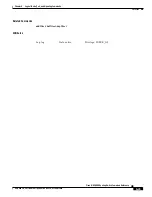
6-31
Cisco MGX 8850 Routing Switch Command Reference
Release 2.0, Part Number 78-10467-04 Rev C0, October 2001
Chapter 6
Logical Node, Port, and Signaling Commands
cnfpnctlvc
cnfpnctlvc
Configure Port Control Virtual Channel—configure bandwidth parameters for a control channel.
The cnfpnctlvc command lets you configure bandwidth parameters for two types of control channels on
a port. The types of control channels are service-specific connection-oriented protocol (SSCOP) and
PNNI routing control channel (PNNI-RCC).
Before using cnfpnctlvc, note the following:
•
You can execute cnfpnctlvc for one type of control VC at a time.
•
A control VC belongs to a special service type called virtual switch interface signaling (VSI-SIG).
A VSI-SIG connection behaves like a VBR-nrt connection.
•
The port must be down for you to execute cnfpnctlvc (so you may first have to use dnpnport).
•
The bandwidth used by control-type VCs (including ILMI, when enabled) adds to the bandwidth
load on the port. Use dspload to determine the load on port resources.
(The VC for ILMI is also a control channel, but its bandwidth parameters are fixed, as follows:
PCR=1000 cps; SCR=50cps; and MBS=1024 cells).
The controller guarantees bandwidth for control VCs. The reserved bandwidth is proportional to the line
rate (T3/E3, OC3, OC12, and so on). Also, the excess priority for this category is equal to CBR and is
higher than any other category. This scheme protects the flow of control data from bursts in user data.
Cards on Which This Command Runs
PXM45
Syntax
cnfpnctlvc <portid> <vc-type>[<-pcr> {peak cell rate}][<-scr> {sustained cell rate}]
[<-mbs> {Maximum burst size}]
Syntax Description
portid
The portid is the PNNI physical port. The format is [shelf.]slot[:subslot].port[:subport].
See also
PNNI Format, page 6-4
.
vc-type
The type of control VC. The VC types are pnnircc and sscop.
-pcr
The peak cell rate for the control VC.
Range: 1–5000 cells per second
Defaults:
•
If vc-type is pnnircc, the default is 906 cps.
•
If vc-type is sscop, the default depends on the line rate.
















































